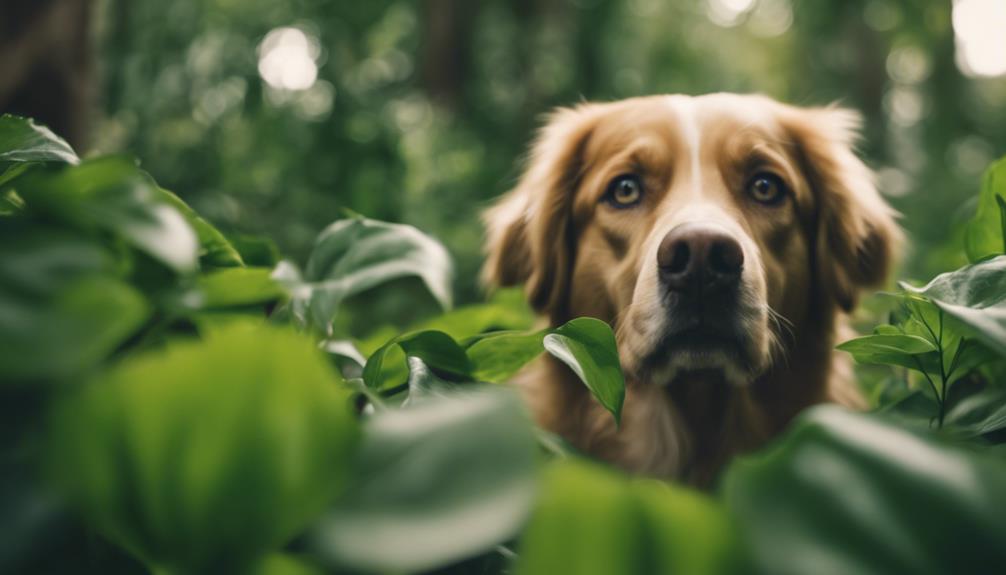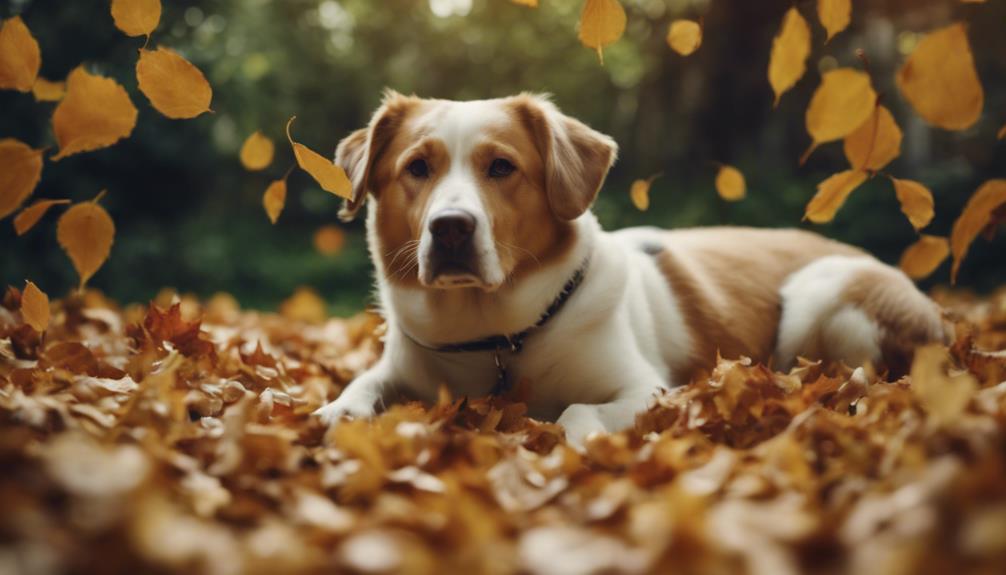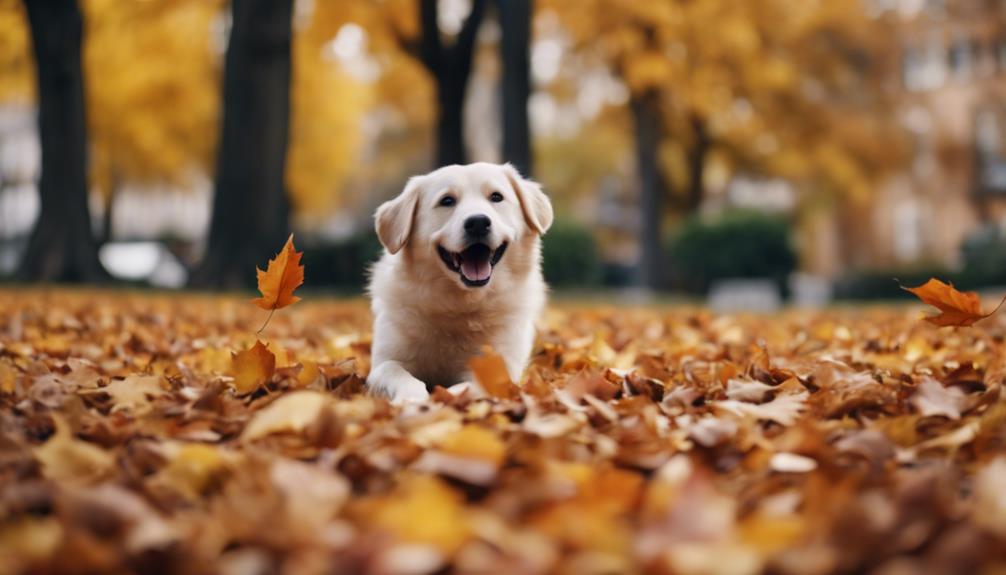The curiosity of dogs towards leaves often prompts pet owners to ponder the potential repercussions of this behavior. While the act of munching on foliage may seem harmless at first glance, a deeper understanding is essential to determine if it poses any risks to canine health.
By considering the nutritional implications, toxicity concerns, and preventive measures associated with dogs consuming leaves, owners can navigate this scenario with informed caution. As the discussion unfolds, insights into the effects of leaf ingestion on dogs' well-being and the necessary steps to address this habit will be revealed.
Key Takeaways
- Dogs may eat leaves for various reasons, including dietary supplementation and inducing vomiting.
- Beware of toxic plants like chrysanthemums and pesticides on leaves that can harm dogs.
- Monitor leaf consumption to prevent intestinal blockages and consult a vet for frequent leaf eating.
- Recognize symptoms of toxicity in dogs and seek immediate vet care if ingestion is suspected.
Reasons Dogs Eat Leaves
Dogs may eat leaves for various reasons, including supplementing their diet, inducing vomiting, and potentially addressing underlying medical conditions like pica.
As omnivores, dogs might consume leaves to fill nutritional gaps in their diet, especially if their regular food lacks essential nutrients.
In cases of gastrointestinal upset, dogs may instinctively eat leaves to trigger vomiting and alleviate discomfort. Additionally, dogs with pica, a condition where animals eat non-food items, may be drawn to leaves.
If a dog shows a persistent inclination towards consuming leaves, consulting a veterinarian is advisable to rule out any underlying health issues. Monitoring leaf ingestion and being cautious of toxic plants can help prevent potential risks associated with dogs eating leaves.
Nutritional Value of Leaves
The nutritional value of leaves varies depending on the type of plant and its specific composition. Some leaves can provide essential vitamins and minerals, while others may lack significant nutritional benefits for dogs. Here is a comparison table showcasing the nutritional content of common leaves:
| Leaf Type | Protein (g) | Fiber (g) | Vitamin A (IU) | Vitamin C (mg) | Calcium (mg) |
|---|---|---|---|---|---|
| Spinach | 2.9 | 0.7 | 2813 | 28 | 99 |
| Kale | 2.9 | 2.6 | 24113 | 80.4 | 254 |
| Lettuce | 1.4 | 0.5 | 361 | 2 | 29 |
| Carrot Tops | 1.3 | 2.1 | 16168 | 5.9 | 185 |
| Dandelion | 2.7 | 3.5 | 508 | 35 | 187 |
Inducing Vomiting With Leaves

Inducing vomiting using leaves as a remedy for ingesting harmful substances is a practice that some pet owners consider in emergency situations. While inducing vomiting should only be done under veterinary guidance, some believe that certain leaves can help expel toxins from a dog's system.
Here are some tips to consider:
- Consult a Veterinarian: Always seek professional advice before inducing vomiting.
- Use Safe Leaves: Certain leaves like grass or those recommended by a vet may be safer options.
- Monitor Closely: Keep a close eye on your dog during the process.
- Provide Water: Ensure your dog stays hydrated throughout the ordeal.
- Seek Immediate Veterinary Care: If in doubt or if your dog shows signs of distress, seek immediate veterinary assistance.
Pica and Leaf Consumption
Pica, an abnormal craving for non-food items, can lead to leaf consumption in dogs. This condition may drive dogs to eat leaves despite their lack of nutritional value. Dogs exhibiting pica may consume leaves as a form of exploration or due to underlying medical issues.
While occasional leaf ingestion is generally harmless, excessive consumption can lead to gastrointestinal problems such as blockages. It's crucial for pet owners to monitor their dogs closely, especially if pica is suspected. Consulting a veterinarian for proper diagnosis and management is advisable to address any underlying causes prompting this behavior.
Understanding and addressing pica can help prevent potential health complications associated with dogs consuming leaves.
Risks of Toxic Plants

Dogs need careful supervision to avoid ingesting toxic plants, which can pose serious health risks. Some common plants can be harmful to dogs, causing various health issues. It is crucial for pet owners to be aware of the potential dangers associated with toxic plants. Here are some risks to consider:
- Certain plants like chrysanthemums, autumn crocuses, and Japanese yews are toxic to dogs.
- Pesticides on leaves can be harmful if ingested.
- Ingesting too many leaves can lead to intestinal blockages.
- Toxic plants may cause symptoms like upset stomach, drooling, tremors, or seizures.
- Awareness of surrounding plants and trees is essential to prevent toxicity and ensure your dog's safety.
Harmful Pesticides on Leaves
To ensure the safety and well-being of dogs, pet owners must be vigilant about the potential risks associated with harmful pesticides that can be present on leaves.
Pesticides are chemicals used to protect plants from pests but can be toxic to dogs if ingested. Dogs that consume leaves treated with pesticides may experience symptoms such as vomiting, diarrhea, lethargy, or even more severe reactions.
It is crucial to be cautious when allowing dogs to interact with foliage from unknown sources, as these substances can pose a significant health hazard.
To safeguard your pet, keep them away from areas where pesticides may have been used and opt for organic or pesticide-free alternatives when possible.
If you suspect your dog has ingested pesticide-laden leaves, seek veterinary assistance promptly.
Intestinal Blockages From Overeating

Intestinal blockages resulting from excessive leaf consumption can pose serious health risks to dogs. These blockages occur when a large amount of leaves forms a mass in the dog's intestines, obstructing the normal passage of food and causing discomfort and potential complications. To prevent such issues, consider the following:
- Provide Adequate Supervision: Monitor your dog closely to prevent overeating of leaves.
- Offer Proper Distractions: Combat boredom by engaging your dog in activities they enjoy.
- Increase Interaction: Enhance playtime and provide interactive toys to divert their attention.
- Encourage Socialization: Arrange playdates with other dogs to keep your pet mentally stimulated.
- Consult a Professional: If you suspect your dog has consumed an excessive amount of leaves, seek advice from a veterinarian promptly.
Monitoring for Toxicity Symptoms
Excessive consumption of leaves can lead to serious health concerns in dogs, necessitating vigilant monitoring for symptoms of toxicity. If your dog has been munching on leaves, be observant for any signs of illness.
Symptoms of leaf toxicity in dogs may include upset stomach, drooling, tremors, seizures, or behavioral changes. It is essential to seek immediate veterinary care if you suspect your dog has ingested something toxic.
Keeping a list of toxic plants handy for reference can aid in quick identification. Regularly monitoring your dog's behavior and health after outdoor activities can help detect any issues early on. Educating yourself about common toxic plants in your area is crucial for ensuring your dog's well-being.
Preventing Excessive Leaf Consumption

Monitoring your dog's outdoor activities can help deter the potential for excessive leaf consumption. Here are five strategies to prevent your pup from munching on too many leaves:
- Supervise Outdoor Time: Keep a close eye on your dog while they are outside to intervene if they start eating leaves.
- Training: Teach the 'leave it' command to redirect your dog's attention away from leaves.
- Provide Adequate Nutrition: Ensure your dog is receiving a balanced diet to minimize cravings for non-nutritious items like leaves.
- Enrichment Activities: Keep your dog mentally stimulated with toys, puzzles, and interactive games to reduce leaf-eating out of boredom.
- Regular Exercise: Engage your dog in daily physical activities to prevent them from seeking entertainment in leaf consumption.
Conclusion
In conclusion, understanding the reasons behind dogs' leaf-eating behavior and the associated risks is essential for responsible pet ownership.
By being aware of the potential nutritional value of leaves, risks of toxicity from certain plant species, and the possibility of inducing vomiting or intestinal blockages, dog owners can take preventive measures to safeguard their pets' well-being.
Monitoring for toxicity symptoms and avoiding harmful pesticides on leaves are crucial steps in ensuring the optimal health of dogs.




